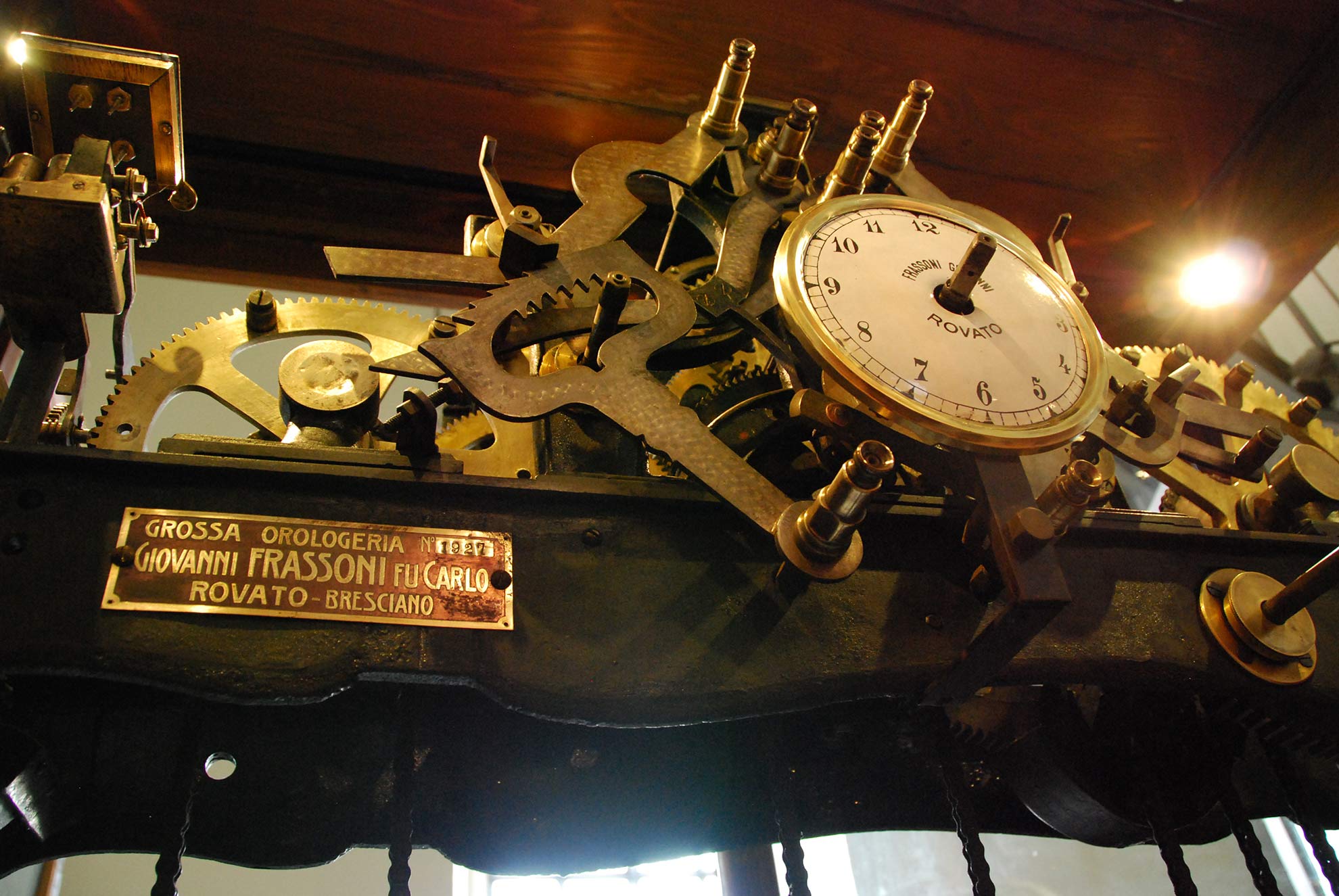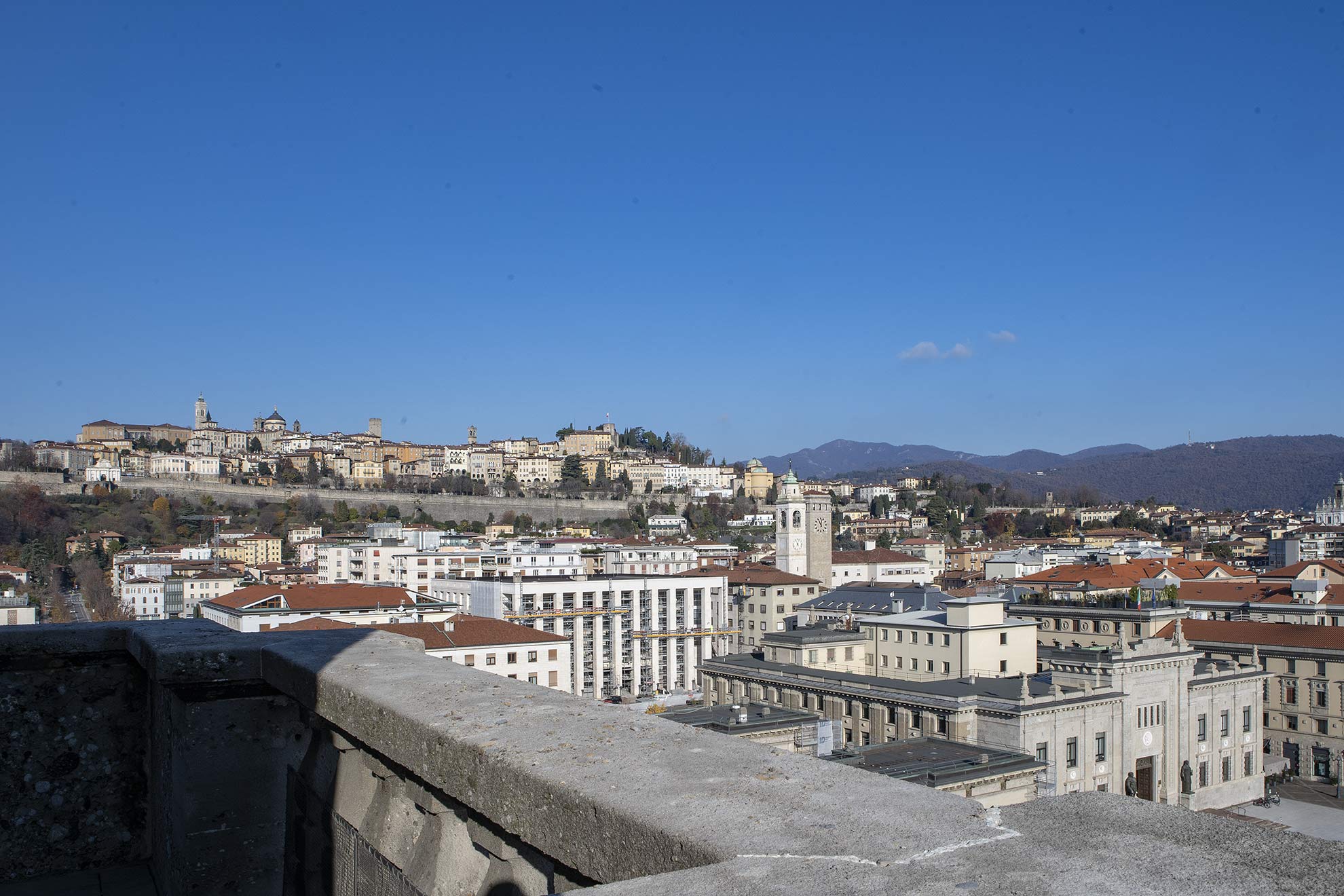In the centre of Lower Bergamo, a few steps from the Porta Nuova porticoes, stands the monument dedicated to those who died during WWI.
Inside, a fascinating exhibition recounts the creation of the Centro Piacentiniano and city life around the Tower, which has become the symbol of modern Bergamo. At the end of the six-storey exhibit, an unprecedented panorama awaits you on the terrace: Bergamo like you’ve never seen it before.

Victorious Italy, Alfredo Faino, 1923
At the centre of the tower, positioned between the clock and large window, is a statue of Victory, completed in 1923. After several surveys and submitted designs, the selection committee decided to award the work to the Bergamo sculptor Alfredo Faino (1885-1944). Initially the sculpture was to be made in Zandobbio stone, but later bronze was chosen. It’s an allegory of Victorious Italy: the woman depicted, dressed in battle clothes, holds Victory in her right hand, while in her left is a sword in a resting position.

Clock gears
Now displayed on the fifth floor of the tower, this mechanism once operated the external two-dial clock. The Chevilles escapement, also known as the ‘pin wheel escapement’, with pins perpendicular to the plane of the escapement wheel instead of traditional teeth, is a unique technical detail. Invented in the early 18th century, it was widely used because it was robust and required very little maintenance. Using the ‘continuous chain’ method, it kept time even during the winding phase, which was carried out every twelve hours. As the company that held the patent for the automatic winding of tower clocks in Italy, Cavalier Giovanni Frassoni was the most important manufacturer in the late 19th and early 20th centuries.

Loudspeaker
The audio system that was used at the Memorial Tower assembles components made by various brands in different years. The loudspeaker was used to broadcast music and speeches to the square below. The LESA-brand turntable is the VE1 model, produced from 1940 to 1948. The radio and amplifier are by the Condor company of Milan. The loudspeaker itself bears the Geloso trademark and appears in the 1953 catalogue. The ‘lily’ shape and the materials used were specially designed for outdoor set-ups. The maximum power of the system was 50 watts.
Torre dei Caduti
Over the decades, the Torre dei Caduti has become the most recognizable symbol of the part of the city designed by Marcello Piacentini.
In the late 19th century, the transfer of the administrative and commercial centre from Upper to Lower Bergamo formalized the transformation of the entire area where the tower stands.
In 1907, Marcello Piacentini and Giuseppe Quaroni‘s design was selected as the winner of the competition for the redevelopment of the area, as it met the requirements of functionality and modernization and respected the vision of the upper city.
The construction of the area was interrupted at the outbreak of WWI and only resumed at the end, with an important modification: the function of the tower had changed. From a decorative building, it became a monument to memorialize Bergamo’s fallen soldiers of the First World War, acquiring a public role

Discover the path
From a purely decorative element to a monument in memory of Bergamo’s fallen soldiers of WWI: a six-stage journey through the history of the building and its exhibition.
01
A war memorial
The first floor of the building reminds us of the sacrifice made by people from Bergamo during WWI
Read More
A war memorial
The monument-hall is dedicated to people from Bergamo who died in WWI. The municipal administration had the 797 names that were known at the time engraved in gold on black marble slabs. To complete the room, the walnut crucifix by the Zonca brothers was added in 1925, based on an old Fantoni model. In 1936, upon the request of the Associazione Combattenti, eight local citizens who died in East Africa were added, including Antonio Locatelli. He is also remembered in the sculptural portrait in the centre of the room, created by Giovanni Avogadri and moved to the tower just after WWII.
02
Bergamo in the Great War
On the second floor, the story of the construction of the tower and life in Bergamo during the Great War
Read More
Bergamo in the Great War
In 1907, the Municipality of Bergamo announced a competition for the ‘construction of the Fairgrounds’. The Panorama project by Marcello Piacentini and Giuseppe Quaroni won. They initially envisaged a tower that was mostly decorative; but, over time, their design changed in appearance and uses. In 1919, Piacentini have it a more austere look, echoing the Campanone in Piazza Vecchia. In 1921, the municipality decided to dedicate it to the memory of local citizens who died in WWI. Work was completed on 2 June 1924 and the tower was inaugurated on 27 October of the same year.
03
Public life at the foot of the tower
Piacentini’s construction reinforced the area around the tower as a centre of local life
Read More
Public life at the foot of the tower
The offices of the public administration, the chamber of commerce, and state and banking institutions were built around the Fairgrounds between the 19th and 20th centuries. This defined the uses and roles of an area perceived of and effectively experienced as a ‘city centre’. The work done by Piacentini and his colleagues in the 1920s reinforced the role and functions of the centre, designing its new architectural look. The Torre dei Caduti became a landmark, an obligatory destination to honour the memory of war and heroism, a balcony from which to address the crowd.
04
Daily life around the tower
On the fourth floor, a focus on leisure and recreation in the heart of Lower Bergamo
Read More
Daily life around the tower
The heart of Lower Bergamo has been a very lively place for centuries. The Fairground complex from the 9th century and St Mark’s Hospital from the 15th were a draw for the flow of people and goods. Other facilities and activities were added later: theatres, cinemas, shops, avenues, cafes, hotels and restaurants. Piacentini’s project was part of this continuity: it accommodated social and commercial needs by extending the arcades and constructing suitable buildings. In the 20th century, the downtown area was the scene of intense social life
05
The old clock
The fifth floor is dedicated to the clock’s inner working
Read More
The old clock
The mechanism, ‘a horizontally shaped clock machine’, operated the clock on the face of the tower before the introduction of electronics. It struck the hours and quarter-hours by means of two bells that could be wound automatically. It was built by a company called Cavalier Giovanni Frassoni of Rovato, the most important manufacturer in the late 19th and early 20th century.
06
Bergamo like you’ve never seen it before!
A 360° panoramic view of the city from the terrace
Read More
Bergamo like you’ve never seen it before!
The exhibition ends on the tower terrace, where a panoramic photograph highlights the most important buildings visible from 45 meters (148 in) above the city, indicating the historical period of each. You will get to see Bergamo from an unusual perspective: on one side you can admire the upper city, the oldest part, surrounded by walls; turning to the right you can see the buildings of Piacentini’s centre and the Sentierone. The next view is to the south, where the end of the boulevard connecting the upper city to the railway station appears. The last side offers a view of Bergamo as it expands towards the plain, in the direction of Milan.
Book your visit
Exciting tours to discover Torre dei Caduti! Enjoy the tower in a natural and playful way, doing something involving. Tour available in english language
Buy the all in one ticket
The six places in the Museum network can be visited with one ticket! It’s called ALL IN ONE and is valid for 48 hours
From March 1 to November 4
Saturday – Sunday & Holidays: 10-13 | 15-18
The building has architectural barriers.
Small dogs are allowed but must be kept in a pet carrier. Guide dogs are permitted at all times.
Full 5 €
Reduced 3€
18-26 years old, Groups of 15 people, discounts
Free
0-17 years old, Amici del Museo delle storie di Bergamo, person with disability and companion, ICOM members, accredited journalists, qualified tour guides, Abbonamento Musei Lombardia